ក្នុងសង្គមខ្មែរ ព្រះសង្ឃតែងនិមន្ត “ចូលព្រះវស្សា” ឬ “គង់ចាំព្រះវស្សា” រយៈពេលបីខែ ដោយកំណត់ពីថ្ងៃ ១រោច ខែអាសាឍ (រវាងខែកក្កដា) ដល់ថ្ងៃ ១៥កើត ខែអស្សុជ (រវាងខែកញ្ញា)។ ទំនៀមនេះ បានជាប់ជាប្រពៃណីប្រតិបត្តិរហូតមក ហើយទាំងព្រះមហាក្សត្រ និងរាស្រ្តសាមញ្ញទូទៅ តែងទំនុកបម្រុងគ្រឿងបរិក្ខាបូជាផ្សេងៗចំពោះព្រះសង្ឃដែលគង់ចាំព្រះវស្សា ដើម្បីបានអានិសង្សដល់ជាតិមុខ។ ក្នុងបណ្តាគ្រឿងបូជាទាំងឡាយនោះ គេឃើញមាន “ទៀនវស្សា” ជាវត្ថុសំខាន់ដែលពុំមានបញ្ញត្តិក្នុងគម្ពីរពុទ្ធសាសនា តែខ្មែរប្រតិបត្តិជាទំនៀមដល់សព្វថ្ងៃ។
ជាការពិត “ទៀន” ពុំមែនមានន័យតែម្យ៉ាងសម្គាល់លើវត្ថុប្រើដើម្បីអុជបំភ្លឺឡើយ តែនៅក្នុងវប្បធម៌ខ្មែរគេសង្កេតឃើញថា ទៀនជាវត្ថុចាំបាច់ក្នុងពិធី ជាគ្រឿងសក្ការបូជាយ៉ាងសំខាន់ដែលមានន័យទាក់ទងនឹងពាក្យថា “ទេព” (divinity)។ ទៀនក្នុងសង្គមខ្មែរមានច្រើនបែបណាស់។ ចន្លុះដែលគេអុជ ហើយកៀសភ្លើងកុំឱ្យរលត់ពេលហែសពហៅថា“ទៀនត្បូង”។ “ទៀនស្នែងក្របី” គេលញ់បត់ឱ្យកោងដូចជាស្នែង ប្រើនៅក្នុងកិច្ចសម្រាប់អារក្ស។ “ទៀនកល្ប” គេអុជសូត្រកាវដាពេលបុគ្គលរៀបស្លាប់ និង “ទៀនវស្សា” ជាទៀនដែលត្រូវមានកម្ពស់៣៣ធ្នាប់ និងទម្ងន់២១ នាឡិ។
តាមសាត្រា “អានិសង្សទៀនវស្សា” ឱ្យដឹងថា ការបូជាទៀនវស្សាបានអានិសង្ស៨ កាល តាមតែប្រាថ្នាអ្វីសឹងបានដូចសេចក្តីប្រាថ្នាទាំងអស់។ សេចក្តីនេះ មានក្នុងរឿងបុរសកំសត់រកស៊ីកាប់អុស ហើយរើសយកអាចម៍ខ្លាឃ្មុំស្លយកក្រមួន លញ់ធ្វើទៀនថ្វាយព្រះដ៏មានបុណ្យ។ ដោយអំណាចបុណ្យរបស់បុរសនោះ ព្រះឥន្រ្ទាធិរាជក៏ជប់ប្រាសាទប្រាក់ ឃ្លាំងមាស ឃ្លាំងប្រាក់ ព្រមទាំងសួនប្រកបដោយដើមឈើ ពេញដោយផ្លែផ្កាសម្បូរហូរហៀរ មានទាំងអ្នកគាល់បម្រើពុំមានខ្វះអ្វីឡើយ។ ដោយឡែក ចំពោះភស្តុតាងនៃការសាងទៀនវស្សាថ្វាយព្រះពុទ្ធសាសនា ហាក់ពុំអាចកំណត់ពីត្រឹមណាជាក់លាក់បានទេ។ ប៉ុន្តែមានសំអាងតគ្នាមកថា កាលឆ្នាំ១៩២៦ ព្រះរាជបណ្ណាល័យនៃពុទ្ធសាសនបណ្ឌិត្យ ធ្លាប់ទទួលវត្ថុសិល្បៈមួយពីវត្តលង្កាក្រៅ ខេត្តសៀមរាប ដែលអ្នកស្រី ម៉ាដឺបូអាហ៊្សែល ការប៉ឺឡែស ជាបណ្ណារក្សសន្និដ្ឋានថា ជាជើងទៀនវស្សា។ វត្ថុនោះធ្វើពីថ្ម កម្ពស់៣៤សង់ទីម៉ែត្រ មានចែកជាពីរផ្នែក។ ផ្នែកទី១ កម្ពស់៥សង់ទីម៉ែត្រ មានលកប្រហោងខាងក្នុង។ ផ្នែកទី២ គឺជាតួដែលមានរចនារូបព្រះរាម ព្រះលក្ស្មណ៍ ហនុមាន និងទ័ពស្វាជញ្ជូនថ្មធ្វើស្ពាន។ មកដល់ពេលនេះ គេរកពុំឃើញរូបថតភស្តុតាងនៃវត្ថុនោះឡើយ។ ប៉ុន្តែទោះដូចម្តេចក្តី នៅក្នុងរូបថតសាលាបារាំង (EFEO) ថតនៅថែវព្រះពាន់ប្រាសាទអង្គរវត្ត បង្ហាញឱ្យឃើញវត្ថុមួយចំនួនរៀបជាជួរមុខព្រះបដិមា មានសណ្ឋានទំនងជាជើងទៀន។
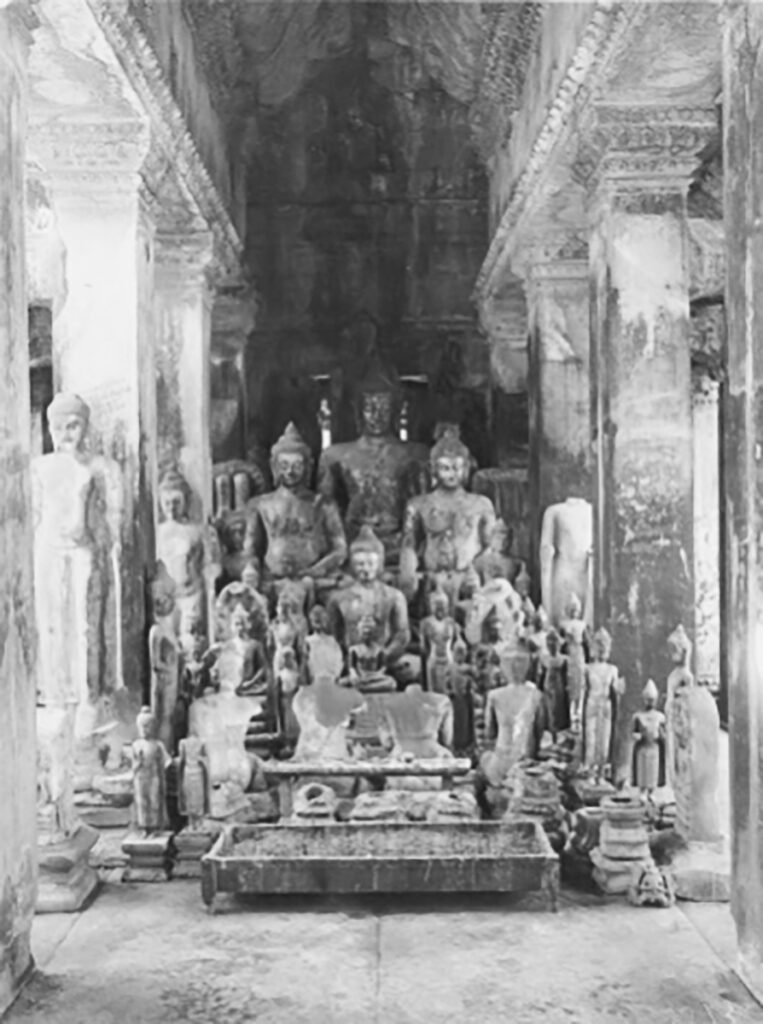
បើផ្អែកតាមសៀវភៅព្រះរាជពិធីទ្វាទសមាសឱ្យដឹងថា កាលនៅក្នុងរាជ្យព្រះបរមកោដ្ឋ (ព្រះអង្គឌួង) ទ្រង់តែងហែទៀនវស្សាក្នុងថ្ងៃ ១៤កើត ខែអាសាឍ និងអុជទៀនវស្សា និមន្តព្រះសង្ឃចូលវស្សា នៅថ្ងៃ ១៥កើត ខែអាសាឍ។ លើសពីនេះ ក្នុងឯកសារឱ្យដឹងដែរថា រៀងរាល់ឆ្នាំក្នុងខែអាសាឍ ព្រះមហាក្សត្រតែងយាងបំពេញព្រះរាជកុសលសិតទៀនវស្សាថ្វាយព្រះរតនត្រ័យ នៅព្រះទីនាំងទេវាវិនិច្ឆ័យ។ ទំនៀមសិតទៀននេះ គឺយកក្រមួនមកស្ងោរឱ្យរលាយរាវជាទឹក ហើយចាក់ដាក់ពុម្ពធ្វើជាទៀន។ ព្រះករុណាជាអម្ចាស់ជីវិតលើត្បូង ទ្រង់ស្តេចយាងចេញធ្វើព្រះរាជកុសលផ្ទាល់ព្រះអង្គ ដោយជួបជុំព្រះរាជវង្សានុវង្ស គណរដ្ឋមន្រ្តី ព្រមទាំងនាហ្មឺនសព្វមុខមន្រ្តីទាំងឡាយ។ កិច្ចនេះក៏ឃើញមានព្រះឆាយាលក្ខណ៍ ព្រះមហាក្សត្រីយានី ស៊ីសុវត្ថិ មុនីវង្ស កុសុមៈនារីរតន៍ សិរីវឌ្ឍនា ស្តេចយាងសិតទៀនព្រះវស្សាដែរ។
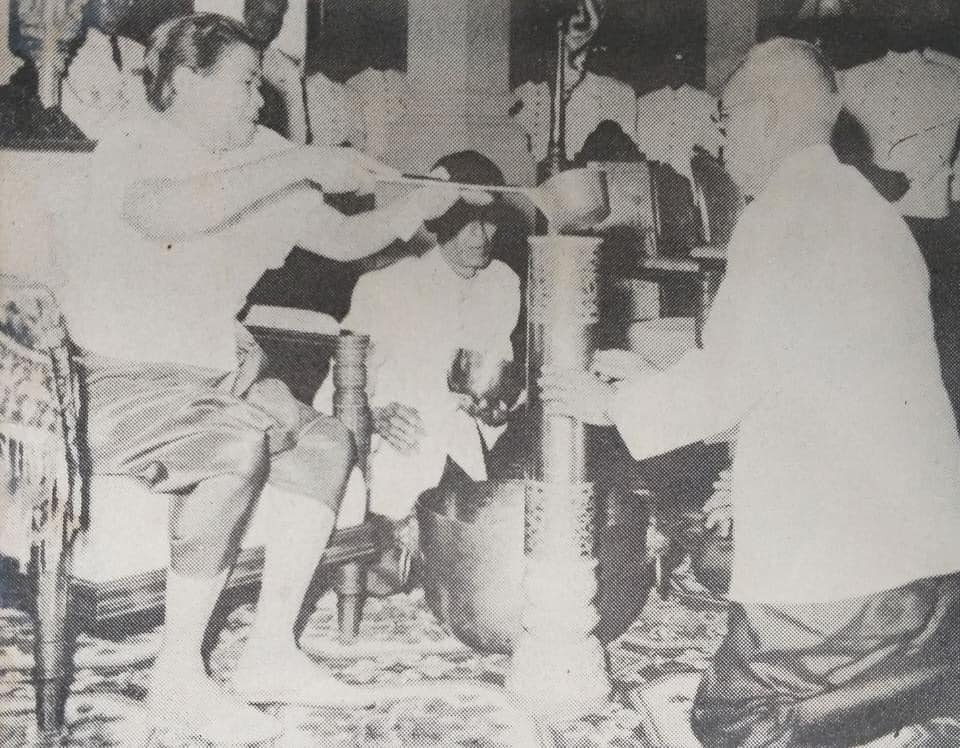
ទំនៀមសិតទៀន និងដង្ហែទៀនព្រះវស្សាព្រះរាជទ្រព្យរបស់ព្រះមហាក្សត្រ នៅក្នុងព្រះបរមរាជវាំង នៅតែបន្តប្រតិបត្តិតាមលំអានរហូតដល់សព្វថ្ងៃ។ ជាទូទៅក្នុងកិច្ចសិតទៀនព្រះវស្សានេះ តែងមានវត្តមានពួកព្រាហ្មណ៍ផ្លុំស័ង្ខ និងភ្លេងពិណពាទ្យប្រគំតាមទំនៀម។ ព្រះមហាក្សត្រ ស្តេចយាងចាក់ទឹកក្រមួនតាមពុម្ពទៀនទាំងអស់ រួចហើយទើបព្រះរាជវង្សានុវង្ស គណរដ្ឋមន្រ្តី នាហ្មឺនសព្វមុខមន្រ្តីចូលទៅចាក់តាមលំដាប់លំដោយរហូតពេញគ្រប់ពុម្ពទៀន។ បន្ទាប់មក ទៀនទាំងនោះត្រូវដង្ហែជាទៀនវស្សាព្រះរាជទ្រព្យ ឆ្ពោះទៅកាន់វត្តអារាមជិតឆ្ងាយ រួមជាមួយនឹងទេយ្យវត្ថុផ្សេងៗតាមព្រះរាជសទ្ធារបស់ព្រះមហាក្សត្រ ប្រគេនដល់ព្រះសង្ឃដែលគង់ចាំព្រះវស្សា។
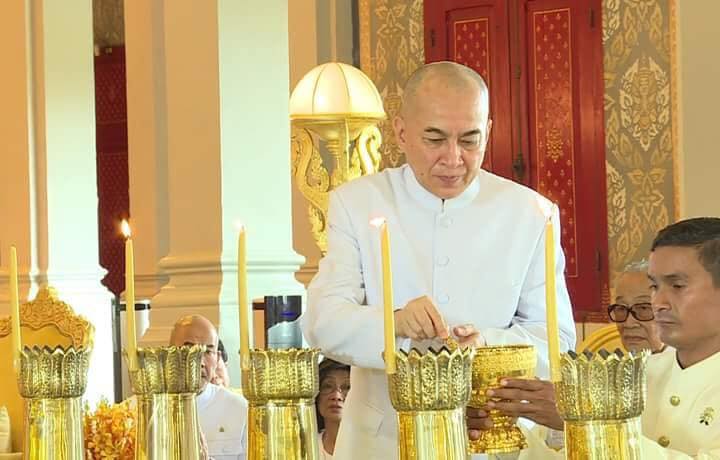

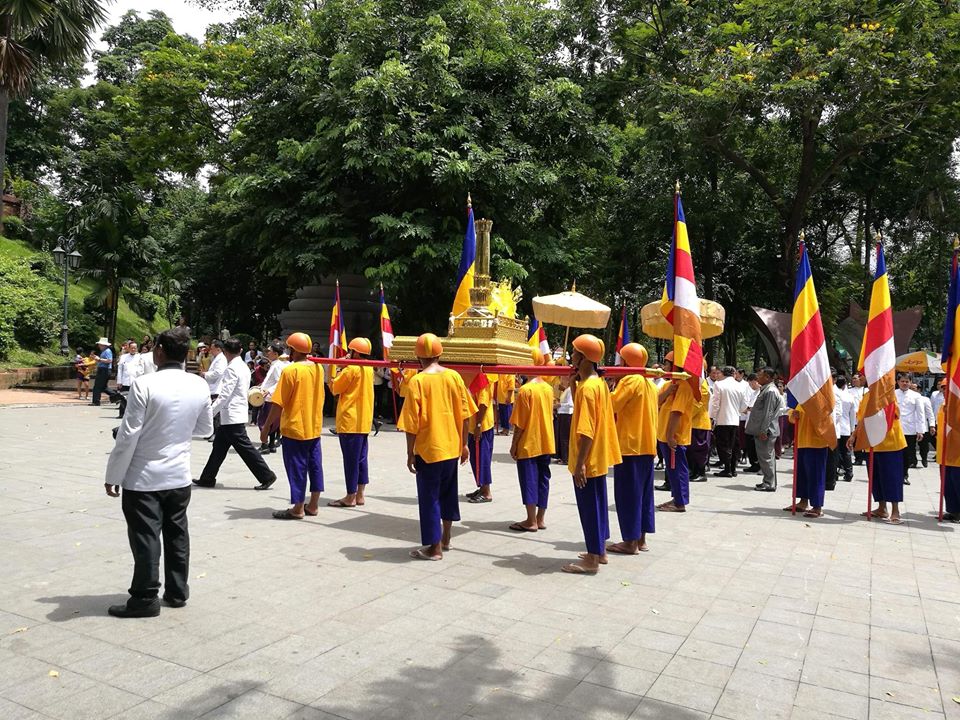
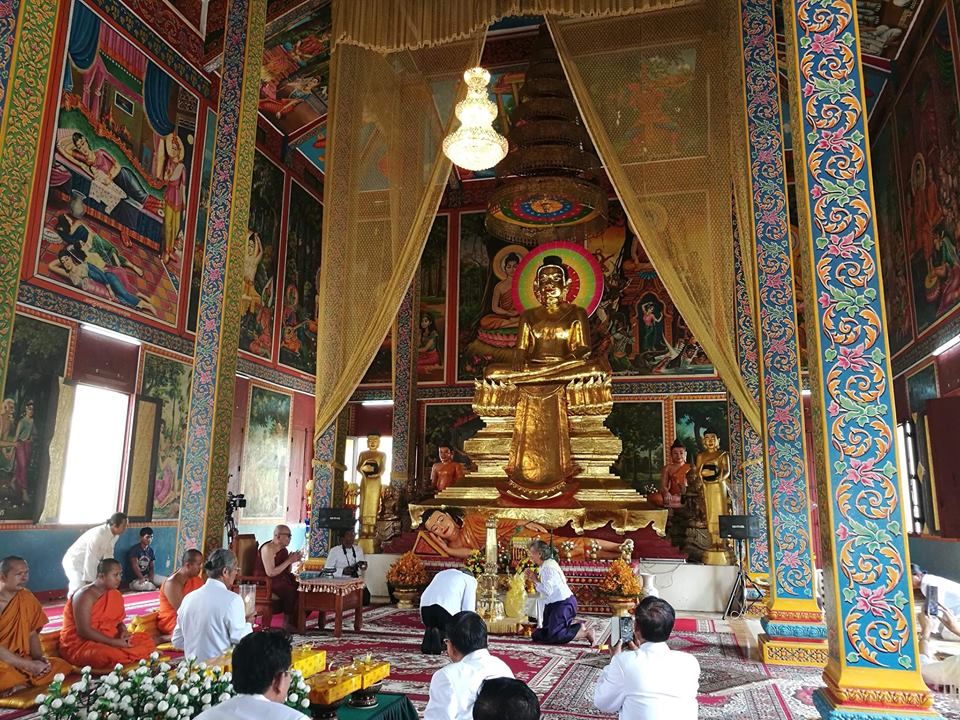
ដោយឡែក ក្រៅពីព្រះរាជពិធីសិតទៀនវស្សាដែលព្រះមហាក្សត្រទ្រង់តែងប្រតិបត្តិដូចរៀបរាប់ខាងលើ ក្នុងរយៈកាលនេះ ប្រជារាស្រ្តជាពុទ្ធបរិស័ទក៏តែងមានសទ្ធាជ្រះថ្លា រៀបចំដង្ហែទៀនវស្សា និងទេយ្យវត្ថុផ្សេងៗប្រគេនដល់ព្រះសង្ឃគង់ចាំព្រះវស្សា តាមបណ្តាវត្តនានាផងដែរ។ ទៀនវស្សា និងទេយ្យវត្ថុទាំងឡាយនោះ គេត្រូវហែប្រទក្សិណព្រះវិហារ៣ ជុំ ទើបនាំចូលទៅវេរប្រគេនព្រះសង្ឃ និងចាប់ផ្តើមអុជទៀន។

(រូបថត៖ AMS-Kien Sereyvuth)
ចំពោះខ្នាតទៀនវស្សា ឯកសារព្រះរាជពិធីទ្វាទសមាសបញ្ជាក់ថា ទៀនខ្នាតតូចមានទំហំ២ចាប់ ឯទៀនខ្នាតធំ មានទំហំ២ចាប់កន្លះ កម្ពស់២ ហត្ថដូចគ្នា។ រីឯសេចក្តីសង្កេតរបស់អ្នកស្រី ពេជ្រ សល់ ថាទៀនវស្សាធម្មតាមានទទឹងមាត់មួយតឹក និងកម្ពស់២ ហត្ថ ធ្វើដោយក្រមួនឃ្មុំ ឬក្រមួនចំបក់។ នៅគល់ទៀន មានជើងទ្រធ្វើពីឈើ មានក្បាច់ត្របកឈូក។ អ្នកខ្លះយកផ្កាមាស ធ្វើដោយស្ពាន់ក្រាប់ទៅបិទជាលម្អលើតួទៀនក៏មាន។ ប៉ុន្តែយ៉ាងក៏ដោយ សព្វថ្ងៃនេះគេសង្កេតឃើញទៀនវស្សាមានផលិតស្រាប់ៗ ដែលពុទ្ធបរិស័ទតែងទិញដង្ហែប្រគេនព្រះសង្ឃតាមវត្តជាធម្មតា។
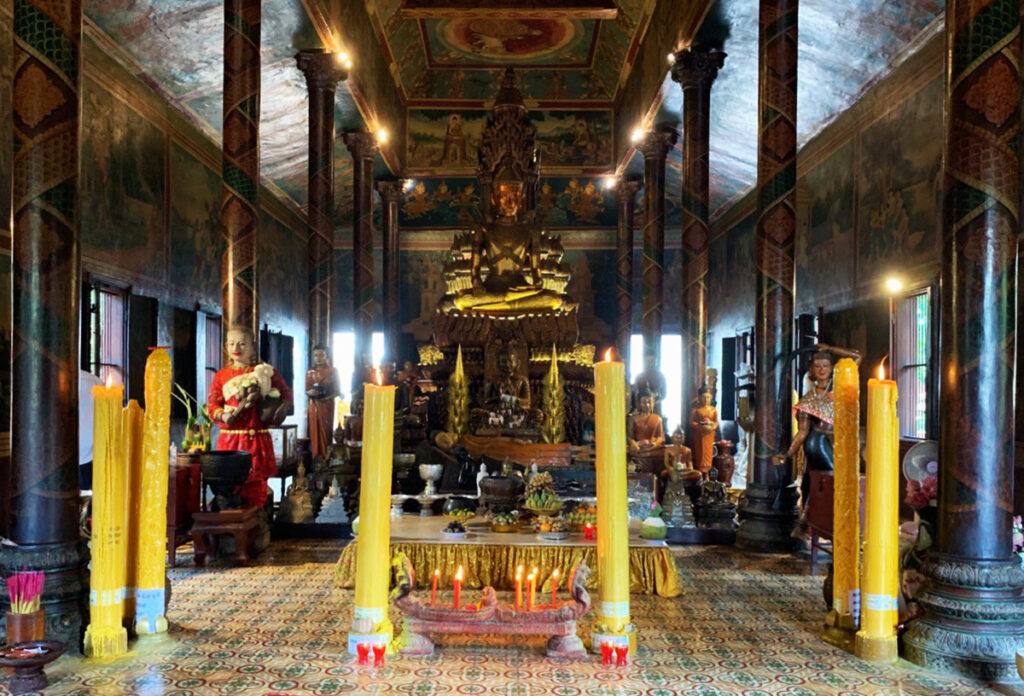
សង្ខេបមក ទៀនវស្សាដែលពុទ្ធបរិស័ទក្នុងសង្គមខ្មែរតែងរៀបចំដង្ហែប្រគេនព្រះសង្ឃគង់ចាំព្រះវស្សា ជាទៀនធំសម្រាប់អុជបូជារយៈពេល ៣ខែ។ រីឯទំនៀមសិតទៀនសោត ជាព្រះរាជកិច្ចដែលព្រះមហាក្សត្រតែងបំពេញរាល់ឆ្នាំពុំដែលរំលងឡើយ។ ប៉ុន្តែមកដល់សព្វថ្ងៃ ប្រជារាស្រ្តជាពុទ្ធបរិស័ទភាគច្រើនបានងាកមកប្រើទៀននាំចូលស្រាប់ ដែលមានលក់លើទីផ្សារ ជំនួសទំនៀមសិតទៀនពីបុរាណមក៕
———————————,
Lent candles and traditions in Khmer society
In Khmer society, the monks are supposed to retreat to their months for three months. It takes from the 1st Roch of Asath of Luna calendar (July) to the 15th Ket of Asuch (September). This tradition is practised by the King to the ordinary people. During this period, Buddhists prepare a lot of offerings. Among them are Lent candles. This ceremony or offering does gain merit for the next life.
A candle is not only used to enlighten the darkness. However, it has a meaning related to God. Candles have many types like Team Tbong (used when procession the dead body), Tean Sneng Krabei (used for Araka ritual), Tean Kab (used while chanting to a person before they die), and Team Vasa (Lent candles). The lent candles are measuring in 33 palms in height and 21 Neal in weight. According to the script “Anisan Tean Vasa”, offering lent candles will get 8 Anisan, and all the wishes will be fulfilled. Based on this concept, there is a story that says a man who works as a woodcutter found the dung of the bear and made it as lent candles to offer the god. The good act of this man makes Indra happy, and he wishes him for a gold resident, storage full of gold and silver, a beautiful and fruitful garden, and servants.
The commencement of making lent candles is unknown. However, it says that in 1926, The library of the Buddhist Institute received an object from the Lanka Krau pagoda in Siem Reap. A librarian suggests that it was the support of lent candles. It is made of stone, 34cm in height and has two parts. First, the part is 15cm and has a hole. The second part is the body which has the decoration with the figure of Rama, Laksmana, Hanuman, and the monkey armies making the bridge to Lanka. Unfortunately, the evidence is not available today. However, based on the photos from EFEO, there could be many lent candles supports installed in front of the Buddha statues in the Thousand Buddha gallery of Angkor Wat.
According to the book calls ” Tvea Dasa Meas” or the twelfth month, King Ang Doung processed lent candles on the 14th Ket of Asath. He lighted them and invited the monks to chant on the 15th Ket of Asath. In Asath annually, the King makes Buddhist lent candles at Dheva Vinnichay (throne hall). To make Buddhist lent candles, the bee wax is melted and poured into the mold by the King.
The tradition of making and processing the Buddhist lent candles and other offerings belong to the King and this tradition is still practiced in the present. The ritual of making Buddhist lent candles starts with Brahmans blowing the sound of Sanka (conch shell) and performing traditional Khmer instruments (Pin Peat). Next, the King pures hot liquid of bee wax into the molds. After the King, the royal family, and the officials fill the bee wax in the molds. After, Buddhist lent candles will be brought to the pagodas with other offerings.
Besides the King, the ordinary Buddhists were able to process the lent candles. The processing will be done three times around a Vihara (praying hall) and then offered to the monk. Lent candles have two dimensions, small and big. The small one is about Pi Chab (15cm in diameter?), and the big one is about Pi Chab Kanlash (about 20cm in diameter?).
In conclusion, the Buddhists lent candles are made to offer the monks who stay three months in the pagoda. Making Buddhist lent candles has been done every year by the King. In the present, every Buddhist could process Buddhist lent candles and offer them to the monks at the pagoda.
អត្ថបទដើម៖ កញ្ញា ហៀន សុវណ្ណមរកត






